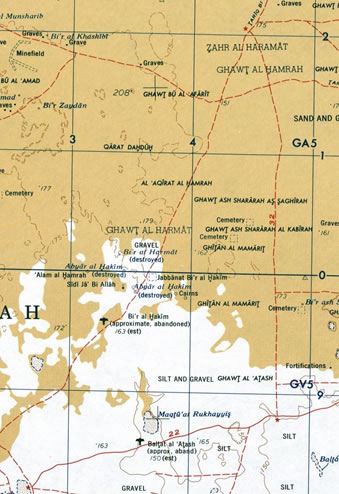| Bir Hakeim:
Seventy-Five Years Later
By Philippe Léonard
August 2017
A few weeks ago, the rocks and sand of a desolate place in the Libyan desert called Bir Hakeim probably throbbed in silence to mark seventy-five years since the guns roared there. In France, that particular celebration day was not forgotten, since Bir Hakeim has a deep meaning for French military prestige and history.
In the first days of June 1942, the southernmost fortified position of the Gazala line was stubbornly defended by a Free French brigade led by General Pierre Koenig against repeated German and Italian assaults. Impeding the supply route of Rommel’s Army swirling around the Gazala line, the Free French had been re-armed by the British but still wielded their very own rag-tag collection of weapons and equipment.
The French resistance at Bir Hakeim truly was a question of honor. The disgrace of the 1940 defeat had to be erased in a heroic battle in order that France and the movement led by Charles de Gaulle would have a future. Determined to obtain such a result, the high morale French troops dug in at Bir Hakeim included tough Foreign Legion volunteers but also Tahitians, Moroccans and Africans, all united to restore the honor of their country.
The fortifications they built in the desert around some old Roman dry wells proved to be a tough nut to crack. The stronghold of Bir Hakeim stretched for about 16 square kilometers, an area centered on a crossroads of caravan routes. At the crossroads stood the ruins of three water tanks, now long buried by the desert sand, indicated by the French on their maps as “Les Mammelles” (“The Tits”). The “tits” stood near Height 186, the highest point of the field, connected by a ridge to the ruins of an old Turkish fort.
At the end of May 1942, after three months of heavy work, Bir Hakeim had been fully entrenched following the French Vauban fortress model. The walls were replaced by minefields and deeply dug-in trenches. Three gates allowed traffic in and out: one in the north-west near the “tits” at the point of the “V” minefield; a second in the south-west beside the ruins of the old Turkish fort; and the third one in the east. The stronghold was surrounded by minefields and subsequently by a Marais (marsh) of mines that extended for 20 kilometers to the north almost to the 150th British Brigade box and to other directions for different depths, which came to more than two kilometers. To build minefields and marshes, 130,000 anti-tank landmines and 2,000 anti-personnel mines were used.

During the night of 10 to 11 of June, after several days of bitter fighting against Rommel’s troops, the encircled French eventually decided to risk a sortie. This bold episode of Bren carriers, trucks and Legionnaires charging 20mm AA guns and brand-new MG 42s in the night has fueled French mythology ever since.
Mike Benninghof also has a story to tell about Bir Hakeim: "When I was in graduate school, Gunther Rothenberg sponsored me for my Fulbright scholarship even though I wasn't one of his students. I've always been grateful for that, and even though he always called me silly for becoming a wargame publisher instead of professional historian and berated me for wasting my talent on trivialities, I do still remember his kindness now that he's gone.
"Gunther was an escaped Jew from Berlin who volunteered to fight the Nazis despite having safely escaped to the United States. He first told me of the Jewish unit that was near Bir Hacheim at the time and overrun, and was rescued by the Legion. I’m no longer sure whether Gunther was present himself, or had friends who were there and related the story to him."
The first time I’ve heard that story I must admit I found it a bit strange since no mention of Jewish troops is made in French recollections of the battle. However, François Milles, author of Des juifs dans le Désert (Jews in the Desert), indeed describes the hard fight of about 400 troops from the Zionist Jewish Brigade, which took place just to the north of Bir Hakeim. They had been deployed laying mines, and were caught by the Axis offensive without heavy weapons or many supplies. Led by Major Liebmann, these soldiers stoutly resisted Italian and German assaults and finally joined the French sortie on June 11.
However this story is often contested, especially on internet forums, since it is not very well documented, absent from General Koenig’s memoir, and strangely located: the Jewish position is supposed to be near Bir-el-Harmat which is a long way to the north-east of Bir Hakeim. Since this story was rather intriguing, I decided to investigate further and what I found is rather interesting. Have a look at the following map of the Bir Hakeim area drawn just after the war.
 It clearly appears from the map that Bir-el-Harmat is effectively very close to Bir Hakeim while another area, with a similar name (El Hamrah), is the location farther north, near « Knightsbridge » where most of the Gazala fighting between Panzer Armee Afrika and the British took place. It’s very strange that most of the historical sources mistake one place for another. It clearly appears from the map that Bir-el-Harmat is effectively very close to Bir Hakeim while another area, with a similar name (El Hamrah), is the location farther north, near « Knightsbridge » where most of the Gazala fighting between Panzer Armee Afrika and the British took place. It’s very strange that most of the historical sources mistake one place for another.
In anyway, this simple map observation is a true gift to celebrate the Free French stand at Bir Hakeim alongside their brothers-in-arms from the Jewish Brigade.
Re-fight France's great desert victory! Order Gazala 1942 right now!
|
